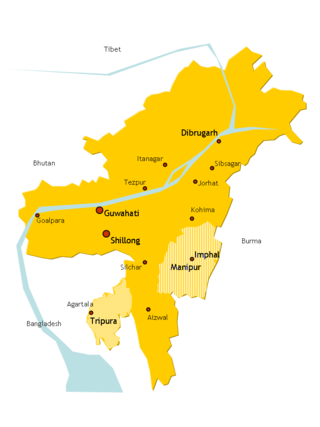Related Research Articles

The history of Mizoram encompasses the history of Mizoram which lies in the southernmost part of northeast India. It is a conglomerate history of several ethnic groups of Chin people who migrated from Chin State of Burma. But information of their patterns of westward migration are based on oral history and archaeological inferences, hence nothing definite can be said. The recorded history started relatively recently around the mid-19th century when the adjoining regions were occupied by the British monarchy. Following religious, political and cultural revolutions in the mid-20th century majority of the people agglomerated into a super tribe, Mizo. Hence the officially recognised settlement of the Mizos became Mizoram.
Zo is a Northern Kuki-Chin-Mizo language originating in western Burma and spoken also in Mizoram and Manipur in northeastern India.
The Kuki-Chin–Naga languages are a geographic clustering of languages of the Sino-Tibetan family in James Matisoff's classification used by Ethnologue, which groups it under the non-monophyletic "Tibeto-Burman". Their genealogical relationship both to each other and to the rest of Sino-Tibetan is unresolved, but Matisoff lumps them together as a convenience pending further research.
Thadou, Kuki, or Thado Chin is a Sino-Tibetan language of the Northern Kuki-Chin sub-branch. It is spoken by the Thadou people in Northeast India. The speakers of this language use Meitei language as their second language (L2) according to the Ethnologue.
The Halam community are various tribes native to the state of Tripura in India. The name Halam was coined by the Tipra Maharaja. As per their oral tradition they called themselves "Riam", which literally means "Human being". And lyrically they also call themselves "Riamrai, Chepvon, Reivon, Longvon etc.". The Halam are further divided into 12 sub-tribes, namely Sakachep, Chorei, Molsom, Hrangkhol, Kaipeng, Kalai, Ranglong, Thangachep, Bongcher, Korbwng, Dab and Rupini.

The Khelma, also known as the Sakachep are one of the Old Kuki tribes of northeastern parts of India.
The Kuki-Chin-Mizo languages are a branch of the Sino-Tibetan language family spoken in northeastern India, western Myanmar and southeastern Bangladesh. Most notable Kuki-Chin-speaking ethnic groups are referred to collectively as the Zo people which includes: the Mizo of Mizoram, the Kuki of Manipur, Assam, Nagaland, Tripura and Bangladesh and the Chin of Chin State, Myanmar.
The Lai languages or Pawih/Pawi languages are various Central Kuki-Chin-Mizo languages spoken by the Lai people or Pawi. They include “ Laiṭong” (Falam-Chin) spoken in Falam district, Laiholh (Hakha-Chin) spoken around the Haka (Hakha/Halkha) capital of Chin State in Burma (Myanmar) and in the Lawngtlai district of Mizoram, India. In Bangladesh, a related language is spoken by the Bawm people. Other Lai languages are Mi-E, and the Zokhua dialect of Hakha Lai spoken in Zokhua village.

The Biates are an ethnic hill tribe of Assam, Meghalaya, Mizoram, Tripura and Manipur. Their language belongs to the Tibeto-Burman family. Spread over many parts of North-East India, they have a unique identity with a rich and distinctive history, culture, dialect and religious heritages. They are one of the oldest hill tribes of North East India especially among the Chin-Kuki-Mizo people. The term Biate comes from the word Bia-te. The word ‘Bia’ or ‘Biak’ means ‘speak’ or ‘worship’. ‘Te’ is a suffix denoting plurality. Hence, the two words combine to form the word Biate, which means worshipper.
Khumi, or Khumi Chin, is a Kuki-Chin-Mizo language of Burma, with some speakers across the border in Bangladesh. Khumi shares 75%–87% lexical similarity with Eastern Khumi, and 78-81% similarity with Mro-Khimi.
Senthang is a Kuki-Chin-Mizo language of Burma. The Senthang dialects share 79% to 95% lexical similarity.
Ralte is a Kuki-Chin language of India. Fewer than a thousand Ralte people speak the language.
Gangte is a Sino-Tibetan language of Kuki-Chin linguistic sub branch of Northeastern India. Its speakers primarily live in Manipur and the adjacent areas of Meghalaya and Assam. The language appears to be homogeneous with no known dialectal variation and exhibits at least partial mutual intelligibility with the other Chin-Kuki-Mizo dialects of the area including Thadou, Hmar, Vaiphei, Simte, Kom and Paite languages. The speakers of this language use Meitei language as their second language (L2) according to the Ethnologue.
Shö is a Kuki-Chin language dialect cluster of Burma and Bangladesh. There are perhaps three distinct dialects, Asho (Khyang), Chinbon, and Shendu.
Thor, also known as Tawr, Laamtuk Thet, or Ruavan Thet, is a Kuki-Chin language spoken in two villages of Hakha Township, Chin State, Myanmar.
Ranglong is an ethnic people belonging to the Kuki people. The majority of the Ranglong people live in a small and densely-packed area in the northeastern part of India, mainly in the border areas of Tripura, Assam and Mizoram.
The Saihriem language is spoken by a mixture of the Saihriem/Faihriem people- a sub tribe of Hmar group of tribes of the Chin-Kuki-Mizo and other ethnically closely related people such as the Aimol, Kuki, Vaiphei, in four neighbouring villages around Dwarbond in Bojalenga Block of Cachar District, Assam.
Northern Kuki-Chin is a branch of Kuki-Chin languages. It is called Northeastern Kuki-Chin by Peterson (2017) to distinguish it from the Northwestern Kuki-Chin languages. VanBik (2009:31) also calls the branch Northern Chin or Zo.
Central Kuki-Chin is a branch of the Kuki-Chin languages. Central Kuki-Chin languages are spoken primarily in Mizoram, India and in Hakha Township and Falam Township of Chin State, Myanmar.
The Maraic languages are a branch of Kuki-Chin languages.
References
- ↑ Sakachep at Ethnologue (25th ed., 2022)

- ↑ VanBik, Kenneth. 2009. Proto-Kuki-Chin: A Reconstructed Ancestor of the Kuki-Chin-Mizo Languages. STEDT Monograph 8. ISBN 0-944613-47-0.
